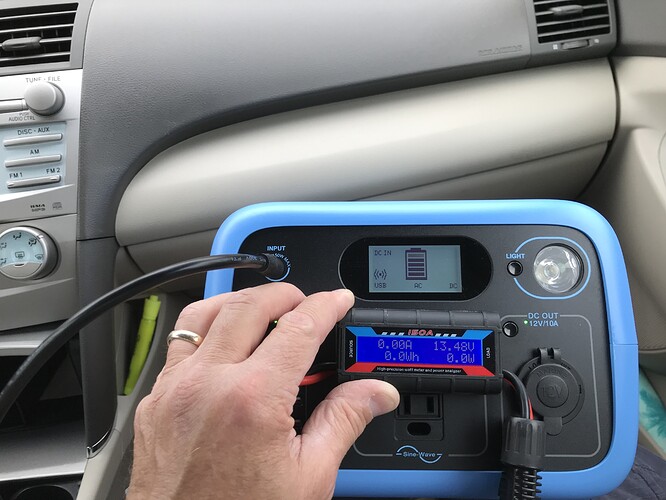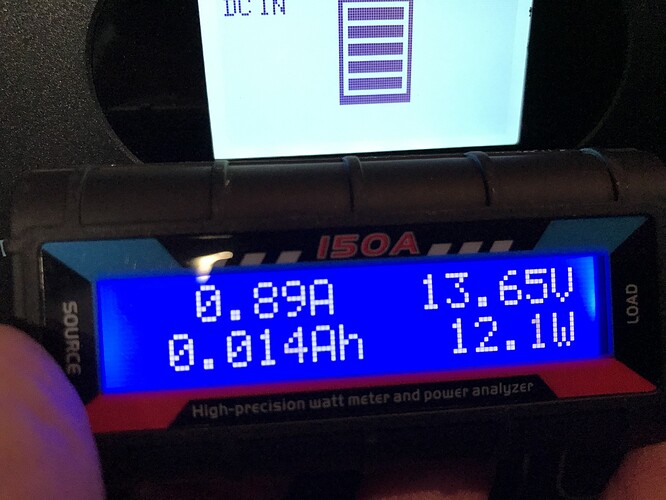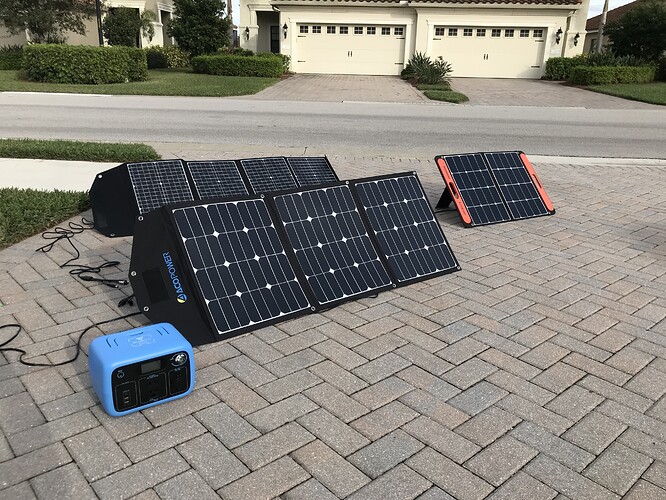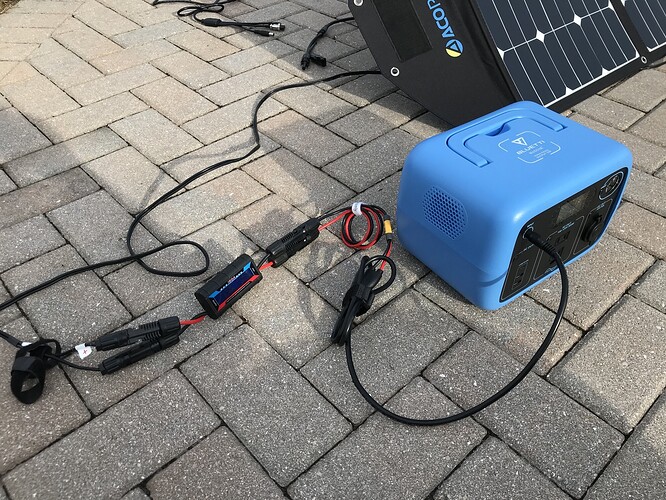I received my AC30 yesterday and unboxed it right away. The unit was well packaged with foam inserts and sturdy corrugated box. The outer box had minor damage indicating it was dropped upside down on the corner, but the AC 30 received no damage thanks to the quality packaging. Inside the box were the Operators manual, warranty card and AC charger. This model is intended as an entry level Power station with few bells and whistles. My initial impression is that it is constructed from quality materials, small and lightweight in size and should be simple to operate even for a first time power station user.
My unit came 80% charged and I charged it to 100% with the supplied charger. The AC30 exterior is basic and contains:
Display Panel that includes a battery level 5 segment bar to view remaining battery capacity and indicators that display DC IN (Charging), USB, AC, DC or LED light operating. The panel does not include displaying input or output wattage which would be nice but is not necessary for an entry level unit such as this.
Charging Input is a 7909 female socket (Same as the AC50 or Jackery)
DC Out power button to turn on the 3 USB ports
AC Out power button to turn on the two 300 total watt rated AC power outlets
DC Out power button to turn on the cigarette lighter 12 VDC 10 amp rated outlet
Light button to turn on the three mode (Low / High / SOS) built in LED light.
To wirelessly charge an item place it battery side down in the center of the top of the AC30. The DC out switch above the USB ports must be pressed for two seconds to activate the wireless charging pad. Make sure the green DC out light is on. Unfortunately I was unable to test the wireless charging on top of the unit because this old man does not own any wireless charging capable devises.
Performance:
The first test I performed was an inverter capacity test. The AC30 inverter is rated for 300 continuous watts and is a full sine wave inverter. I was able to power the full 300 watts ![]() for as long as the battery capacity remained. I was curious about how much above the 300 watt limit I could push this little guy. I was able to pull a full 375 watt load
for as long as the battery capacity remained. I was curious about how much above the 300 watt limit I could push this little guy. I was able to pull a full 375 watt load ![]() without tripping the overload. After being surprised with the AC inverter capacity, I ran the 375 watt load for a full ten minutes with no problems! I shut off the test after 10 minutes, because I didn’t want to stress this new unit too much. Over 375 watts, the overload would trip nececcetating the AC button be pressed again to re-set.
without tripping the overload. After being surprised with the AC inverter capacity, I ran the 375 watt load for a full ten minutes with no problems! I shut off the test after 10 minutes, because I didn’t want to stress this new unit too much. Over 375 watts, the overload would trip nececcetating the AC button be pressed again to re-set.
Fan operation……Now for the great part. The AC-30 is totally silent ![]() when turning on the inverter. The fan remained silent during all my 300 watt load testing. Only when I was running the overload of 375 watts for 8 minutes did the fan come on. When the fan comes on it sounds very smooth, but powerful. It is by no means a quiet fan, but is not overly loud either. After the fan ran for two minutes it shut off again. This machine is one of the best I have run with regards to the fan run times. When I camp in a tent, I don’t want to hear any fan at all and the AC30 seems to be perfect with its silent operation unless heated.
when turning on the inverter. The fan remained silent during all my 300 watt load testing. Only when I was running the overload of 375 watts for 8 minutes did the fan come on. When the fan comes on it sounds very smooth, but powerful. It is by no means a quiet fan, but is not overly loud either. After the fan ran for two minutes it shut off again. This machine is one of the best I have run with regards to the fan run times. When I camp in a tent, I don’t want to hear any fan at all and the AC30 seems to be perfect with its silent operation unless heated.
Battery capacity test……After being pleasantly surprised with the inverter capacity and the fan operation, I wanted to test the batter capacity. The AC30 has a Lifepo4 battery chemistry which means that you can charge and discharge this power station a few thousand times before the battery loses more than 20 of its original capacity. This is one of the best features of the AC30.
Immediately after running the 375 watt AC overload test, I charged the battery back up from approx. 60% to 100% by using my variable voltage power supply to “fast charge” at 144 watts instead of the supplied charger which operates at 40 to 45 watts. I wanted to stress the unit at a high charge rate to determine if it was actually capable of receiving 150 watts of input. I topped off the charge in less than an hour and during the fast charge the fan would come on about every 10 minutes and run for a minute or so before shutting off. I could not feel much heat by touching the outer case and the air coming out of the fan grill was slightly warm.
After insuring the battery was full, I connected the AC 30 to my 55” Samsung TV and pulled 150 watts steadily until the battery was depleted and unit shut off. During this time, the AC 30 was still warm from the charging and inverter capacity test. The fan would come on again about every 15 minutes or so and run for a minute or two. The results of the battery capacity test were that the AC30 was able to output 285-watt hours ![]() from its 300-watt hour capacity battery. I then recharged the battery overnight using the Bluetti supplied slow charger (about 8 hours). I was able to put back in 305 watt hours so the advertised capacity and the overall battery efficiency are** excellent**. Keep in mind again, this performance was achieved on an “entry level” unit.
from its 300-watt hour capacity battery. I then recharged the battery overnight using the Bluetti supplied slow charger (about 8 hours). I was able to put back in 305 watt hours so the advertised capacity and the overall battery efficiency are** excellent**. Keep in mind again, this performance was achieved on an “entry level” unit.
12 Volt Accessory Outlets: The 12 Volt DC accessory outlet output measured 13.2 volts and is not regulated. This however is not a negative in general. Regulating a 12 volt output consumes power itself and makes using the 12 volt outlet less efficient than a non regulated one. Secondly the LifePO4 battery chemistry of the AC 30 means that while the battery drains from 100% to 0% the voltage remains fairly steady through the first 90% (Approx) of the discharge cycle. The last 10% is still usable voltage, but it does drop off at an higher rate than the first 90%. So…what does this mean? You can power your fridge or other accessories with high battery efficiency without the need for 12 volt regulation. You can use the last 10% of capacity, but in truth it is best not to fully discharge the battery to 0% each time anyway.
Charging Options:
OEM Supplied charger……40 to 45 watts slow charger. Takes approx. 8 hours if empty. ![]()
Car Charging……Not available on this unit. ![]() I did test anyway though and was only able to get a max of 17 watts and that was with the engine running at freeway speed. So….for all practical purposes the AC30 will not recharge via a car socket. You could however use a small inverter in your car and run the supplied ac charger off of that.
I did test anyway though and was only able to get a max of 17 watts and that was with the engine running at freeway speed. So….for all practical purposes the AC30 will not recharge via a car socket. You could however use a small inverter in your car and run the supplied ac charger off of that.
After market higher wattage charger….The AC 30 has a very narrow range of input voltage that it will accept but will allow up to 150 watts of incoming charging current. Using my adjustable voltage power supply charging was only possible from 13.4 volts to 14.75 volts. ANYTHING outside this range and no charging would occur. As soon as the voltage exceeded 14.75 volts, charging would stop and to begin again, the charging cord would have to be removed and reinserted.
I have not encountered any other power station that has such a tight voltage range for charging. I had a 19-volt 120 watt charger that I thought would work well with this unit and it would not charge at all. I was disappointed in such a tight range of allowable charging voltage. I have purchased a 14.5-volt 90 watt charger that I think will double the AC charging rate to a more acceptable 4 hours or so. Chargers in this tight voltage range are difficult to find. Below is what I observed with voltage vs charging watts.
13.45 VDC……5.1 watts 13.57 VDC……16.8 watts
14.03 VDC……59 watts 14.28 VDC……85.7 watts
14.54 VDC……121.1 watts 14.74 VDC……143.2 watts
As you can see, voltage plays a huge role in charging watts available. If you had a vehicle that produced 14 volts or more running, I think car charging would work fine for you. The Jackery car charge cord is a direct fit for the AC30 and you can get a car charge cord terminating in the appropriate 8mm male fitting from Amazon.
Solar Charging…… ![]()
![]() After seeing how tight the acceptable voltage range was above, I was skeptical that solar charging would work since most solar panels run at 15 volts or higher while charging. I had three panels I wanted to test. Sun conditions were fair and late afternoon, but I was interested mostly if any charging would occur. The AC 30 does not include a solar panel adapter cable, but I had one on hand to use for testing.
After seeing how tight the acceptable voltage range was above, I was skeptical that solar charging would work since most solar panels run at 15 volts or higher while charging. I had three panels I wanted to test. Sun conditions were fair and late afternoon, but I was interested mostly if any charging would occur. The AC 30 does not include a solar panel adapter cable, but I had one on hand to use for testing.
I have to say I am amazed at the results. All four solar panels charged the AC30 perfectly. I cannot for the life of me understand how all three panel VOC voltages ranged from 22.81 to 26.28 VOC and when I connect them to the AC30 they charge perfectly. The voltages drop and normal charging begins. When I connect the exact same voltage to my adjustable power supply, anything over 14.75 volts fails to charge. It must have to do with the power supply maintaining the voltage when under load and the panels lower the voltage by a large amount when under load.
Below are my individual results for each panel. The day was very cloudy and 4:30 in the afternoon with low sun. Bad solar conditions, but I was mainly wanting to verify charging with each panel. The watts achieved cannot be used for a solar efficiency comparison because the sun was rapidly changing due to cloud cover.
Bluetti 120 watt folding… ![]()
I bought four but did not have them on hand to test with my AC30. When I tested them on my AC200 they ran very well, had great power output and are ruggedly built of high quality materials. I recommend them for the AC30, 50 or AC200 as a panel that works on everything. Since an MC4 to 7909 adapter cable is not included with the AC30, it would have to be purchased separately. These panels can be connected in pairs or even more for the AC200 series. At the time of this review they are available on the Bluetti website for $309.99 on sale.
Paxcess 120 watt folding ![]()
![]()
![]()
![]() ……22.81 VOC…13.74 Volts under load…36.01 watts
……22.81 VOC…13.74 Volts under load…36.01 watts
*(I would recommend this panel for the AC30 and AC50 Bluetti because it comes with a multi connector cable that will connect directly to the 7909 input port of the Bluetti. It is a fairly low cost panel and is well build. It does NOT have MC4 connections though so this should be considered in a single panel configuration only.
Acopower 120 watt folding ![]()
![]()
![]() ……23.96 VOC…13.74 Volts under load…35.3 watts
……23.96 VOC…13.74 Volts under load…35.3 watts
This panel works very well and is thin and light. It is more costly and if using for an AC30 or 50, I think the better bang for the buck is the Paxcess above. It does come with MC4 connections and can be connected with multiple panels if needed for increased output. This is a feature that the Paxcess cannot duplicate
Jackery Solar Saga 60 ![]()
![]()
![]() ……26.28 VOC…13.53 Volts under load…15.4 watts
……26.28 VOC…13.53 Volts under load…15.4 watts
The Jackery solar saga panel cable terminates with a male 7909 connector which mates directly to the Bluetti AC30 and 50. The Jackery panels are very easy set up and built well. They are pricey but work well. They cannot be connected in pairs without purchasing additional costly adapter cables but it is do-able.
Aiper 160 watt folding ![]()
![]() …24.01 VOC…13.76 Volts under load…30.5 watts (very weak sun)
…24.01 VOC…13.76 Volts under load…30.5 watts (very weak sun)
The Aiper 160 is a recent panel for me and I recommend it if you can find them for the $199 I paid. This will give you a single panel with a rated 160 watts. The panel has a cable that is removeable and begins with and XT60 connection and terminates with a 5525 male plug. Several adapters that will connect to the AC30 or 50. I personally made a 10 foot XT60 to MC4 cable so I can connect it to anything.
One interesting thing with the voltage under load is most panels were outputting around 13.75 volts. Almost too much of a coincidence. I think that has to due with the AC30 charge regulation. Not sure why the Jackery was lower unless it was due to it being a much smaller panel.
So, what do I LIKE about the Bluetti AC30: ![]()
Long life cycle battery……At 2000 + battery cycles at this price, how can you go wrong
Inverter capacity……with the 300 watt rated inverter being able to carry a 375 watt load is a great feature for short term overload situations.
Quiet operation……The fan operates only when it needs to and this makes for a very quiet running unit. If you are not running a heavy load the fan will be silent and not operate. Very cool.
Simple operation….This is an entry level unit that lends itself to first time users. It is easy to operate for a user that has limited or no electrical knowledge. With the AC30 you simply press the button of the output you want to use. How many watts am I using or charging with? Don’t know, don’t care? Many users will find the AC30 easy to operate and use.
Solid build quality and materials. For a low cost unit, the fit, finish and feel are great.
So, what do I NOT like about the Bluetti AC30: ![]()
No car charging capability. I think this is a miss for the intended market of this product. Yes you can use a small AC inverter, but you shouldn’t have to.
No solar cable adapter included. Every power station that is capable of solar input should include the solar charging adapter cable necessary to connect the product to a compatible solar panel.
Slow charge rate. The AC30 is capable of inputting 150 watts of charging power. The supplied power brick should provide at least 100 watts to charge in a more reasonable 3 to 4 hours from empty. This is much more of a problem with the very narrow allowable charging voltage which severely limits aftermarket charging choices. Yes, the slow charger will be the best long term for the batteries, but we all need to fast charge now and then.
No incoming and outgoing wattage display. Yeah, I know this is an entry level unit, but I sure would like to see what is going out and in. Very helpful for knowing how much load I am running or even adjusting a solar panel to the maximum solar input.
Conclusion: ![]()
![]()
![]()
![]()
![]() The Bluetti AC30 is a great little entry level unit. The excellent AC inverter and fan performance outshine the charging limitations present due to the allowable input voltage range. If you want a basic unit that provides great performance at a good price you won’t go wrong with the AC 30. They make perfect first (to get your feet wet) second or even third units as well as great gifts for your less than electrical savvy friend or relatives. (“It is the way”)
The Bluetti AC30 is a great little entry level unit. The excellent AC inverter and fan performance outshine the charging limitations present due to the allowable input voltage range. If you want a basic unit that provides great performance at a good price you won’t go wrong with the AC 30. They make perfect first (to get your feet wet) second or even third units as well as great gifts for your less than electrical savvy friend or relatives. (“It is the way”)
emphasized text
















